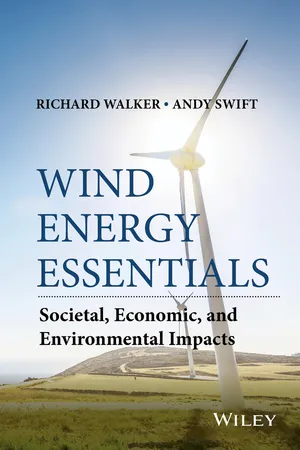
Wind Energy Essentials
Societal, Economic, and Environmental Impacts
- English
- ePUB (mobile friendly)
- Available on iOS & Android
About This Book
Examines the possible societal impacts of wind energy projects and explains the potential issues faced when siting, constructing, and operating a wind energy project.
This book begins with a history of wind power and the social impacts of both electricity and wind power from a historical perspective, a discussion of basic electrical terms, and a primer on the conversion of power in the wind to electricity. Much of the second half of the book is devoted to comparing wind energy to other forms of electric generation, both renewable and non-renewable sources. In order to have a true understanding of the impact of wind energy on society, one also has to have a thorough understanding of the impacts that other sources of electric generation have, such as fossil-fuelled plants or nuclear power plants. The comparison of electric generation sources includes a review of how such sources are typically utilized within the electric system, as well as the economic factors and environmental considerations that affect which resources utilities or operators of electric grids have to take into account. The authors conclude with a discussion of energy policies in the U.S., individual states, and foreign nations, how these policies influence the use of renewable energy, and what our future may hold in terms of energy supply and demand. Some highlights of this book are:
- Discusses the wind energy impacts on the environment, local economy, electric utilities, individuals and communities
- Provides a visual explanation of wind energy principles through tables, graphs, maps, illustrations and photographs
- Offers a comprehensive overview of the issues associatedwith the creation and use of wind energy
- Models chapters around an existing university curriculum
Spanning the broad range of environmental, financial, policy and other topics that define and determine the relationships between wind energy technology and our energy-dependent society, Wind Energy Essentials is a resource for students, universities, and the entire wind energy industry.
Frequently asked questions
Information
1
IMPACTS OF ENERGY AND ELECTRICITY ON SOCIETY
1.1 WHAT ARE “SOCIAL AND ENVIRONMENTAL IMPACTS”?
1.1.1 Interactions and Effects of Technology on Society and the Environment
1.1.2 Sustainable Development
Sustainable development is development that meets the needs of the present without compromising the ability of future generations to meet their own needs. [1]
1.1.3 Wind Power, Technology, and Society
1.2 EARLY WIND POWER INNOVATION AND DISCOVERY
1.2.1 Age of Sail Power

Table of contents
- COVER
- TITLE PAGE
- TABLE OF CONTENTS
- PREFACE
- FOREWORD
- ABOUT THE AUTHORS
- DEDICATION AND ACKNOWLEDGMENTS
- 1 IMPACTS OF ENERGY AND ELECTRICITY ON SOCIETY
- 2 THE BASICS OF ELECTRICITY
- 3 OVERVIEW OF WIND ENERGY AND OTHER SOURCES OF ELECTRICITY
- 4 CONVERSION OF POWER IN THE WIND TO ELECTRICITY
- 5 THE WIND ENERGY DEVELOPMENT PROCESS
- 6 OVERVIEW OF ISSUES FACED BY WIND ENERGY
- 7 WIND AND WILDLIFE: SITING ISSUES AND CHALLENGES
- 8 ENVIRONMENTAL AND ECOLOGICAL IMPACTS OF WIND ENERGY ON HUMANS: PUBLIC HEALTH ISSUES
- 9 ENVIRONMENTAL AND ECOLOGICAL IMPACTS OF WIND ENERGY ON HUMANS: PUBLIC AND WORKFORCE SAFETY ISSUES
- 10 WIND ENERGY'S IMPACT ON AVIATION, RADAR, AND TELECOMMUNICATIONS
- 11 OTHER ENVIRONMENTAL ISSUES OF WIND ENERGY DEVELOPMENT: AESTHETICS, CULTURAL RESOURCES, LAND USE COMPATIBILITY, WATER RESOURCES, AND SITE RESTORATION
- 12 IMPACT OF WIND ENERGYON THE ELECTRIC GRID
- 13 NON-WIND RENEWABLE ENERGY SOURCES USED TO MEET ELECTRICITY NEEDS
- 14 NONRENEWABLE ENERGY SOURCES USED TO MEET ELECTRICITY NEEDS
- 15 ENERGY EFFICIENCY AND CONSERVATION: “LESS IS MORE” AND “DOING WITHOUT”
- 16 GREENHOUSE GAS EMISSIONS
- 17 SITING AND PERMITTING OF ELECTRIC GENERATION PROJECTS
- 18 ECONOMICS OF ELECTRICITY GENERATION
- 19 ECONOMIC IMPACTS AND BENEFITS OF WIND ENERGY PROJECTS AND OTHER SOURCES OF ELECTRIC GENERATION
- 20 ENVIRONMENTAL IMPACTS AND ECONOMICS OF OFFSHORE WIND ENERGY
- 21 STATE AND NATIONAL ENERGY POLICIES
- 22 GLOBAL WIND ENERGY POLICY AND DEVELOPMENT
- 23 WIND ENERGY WORKFORCE, EDUCATION, AND JOBS
- 24 THE FUTURE OF ELECTRIC ENERGY
- APPENDIX A
- APPENDIX B
- APPENDIX C
- INDEX
- END USER LICENSE AGREEMENT